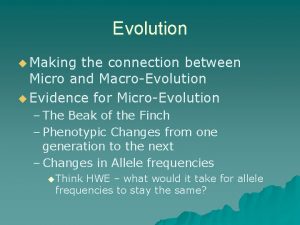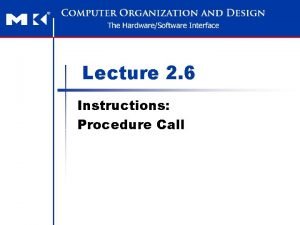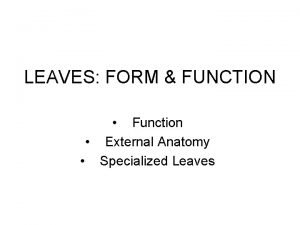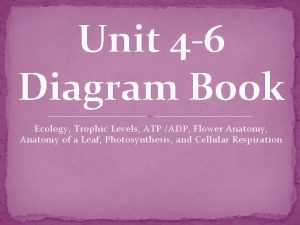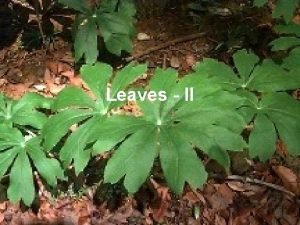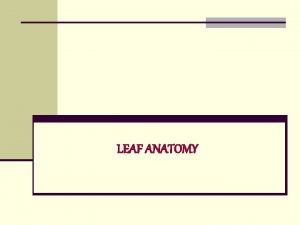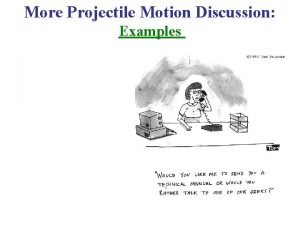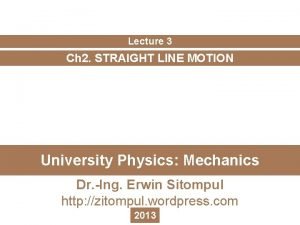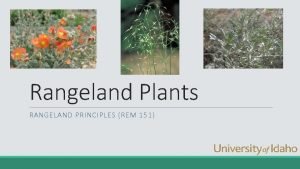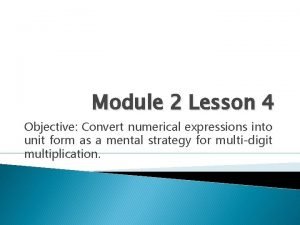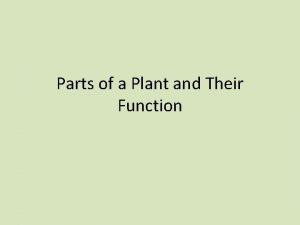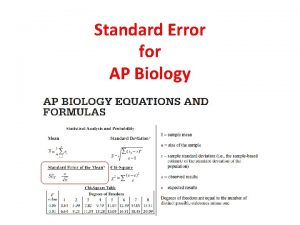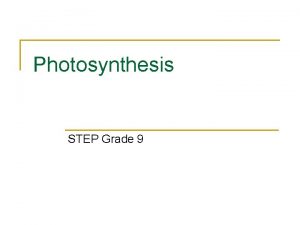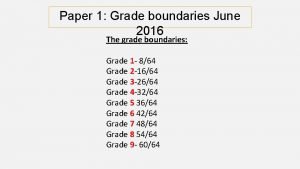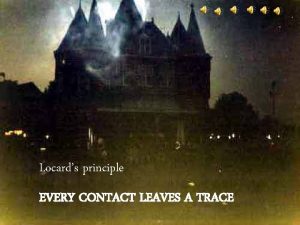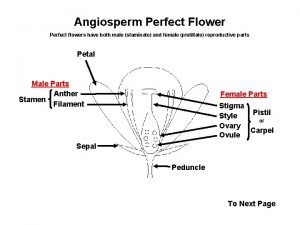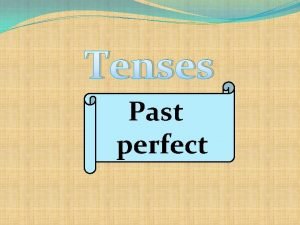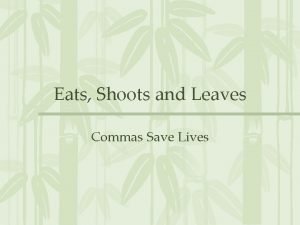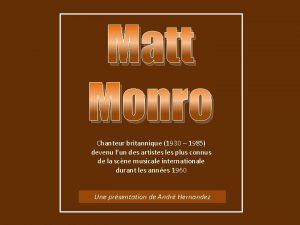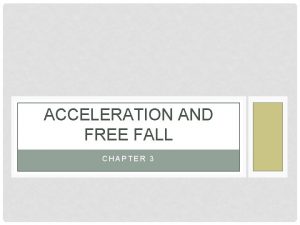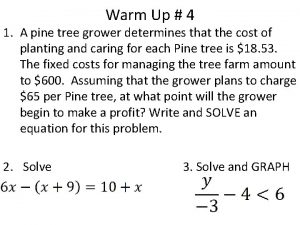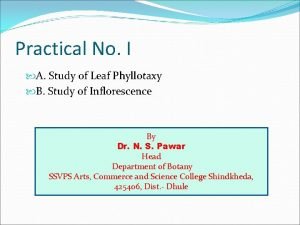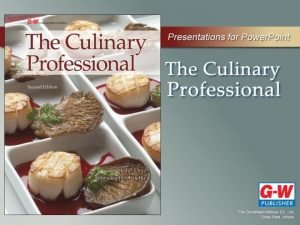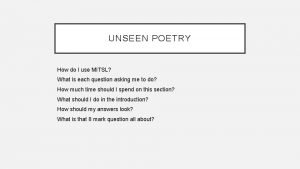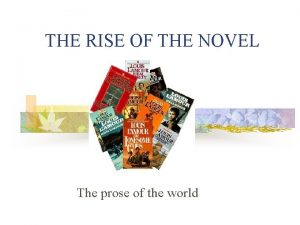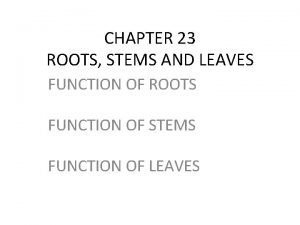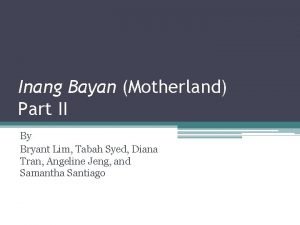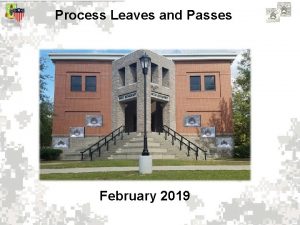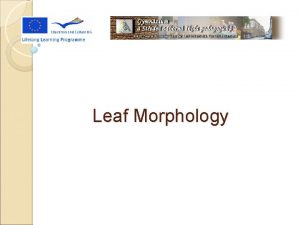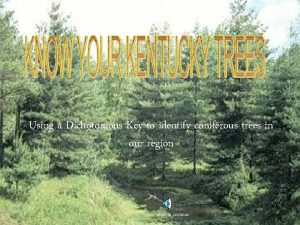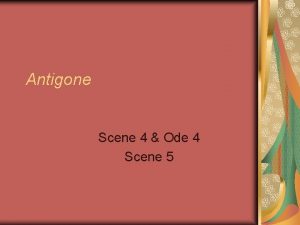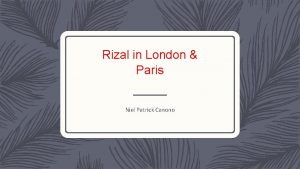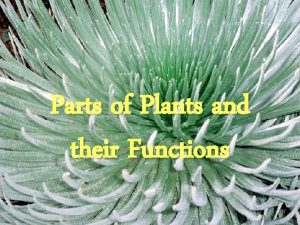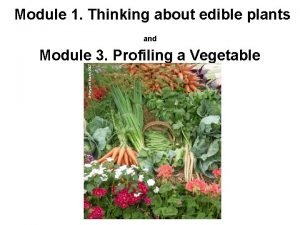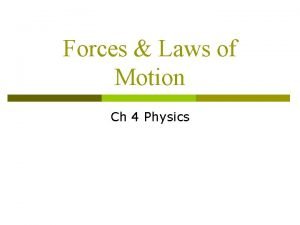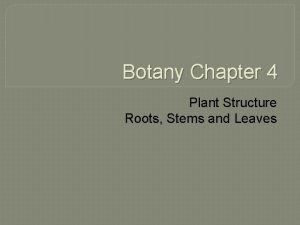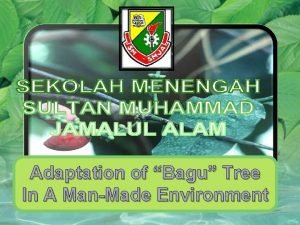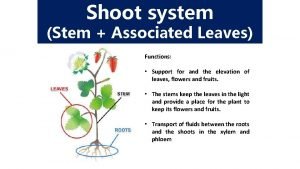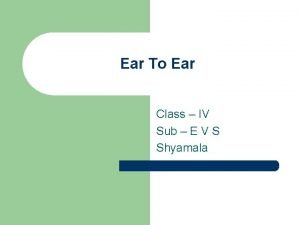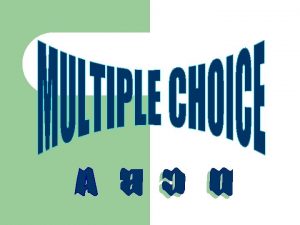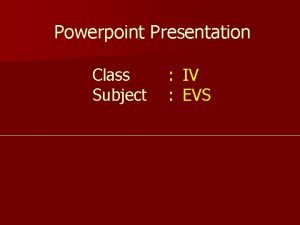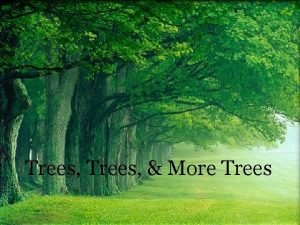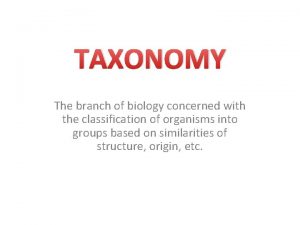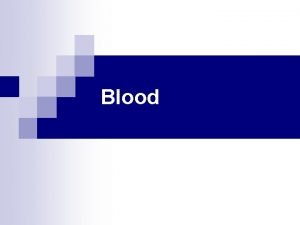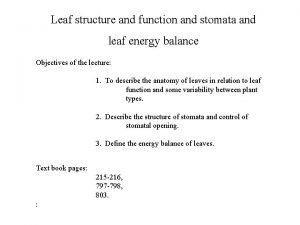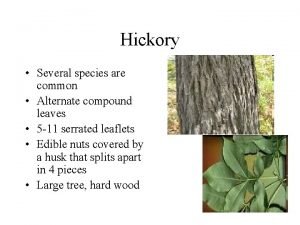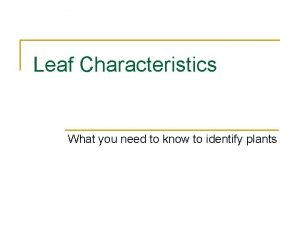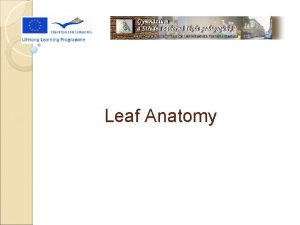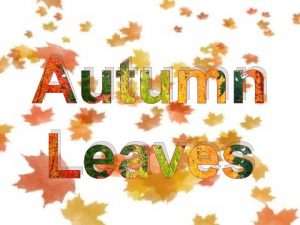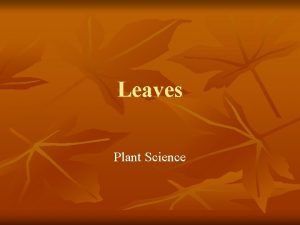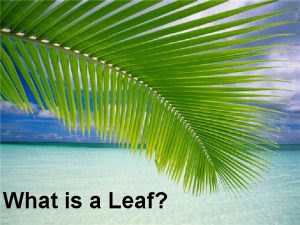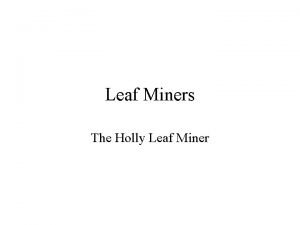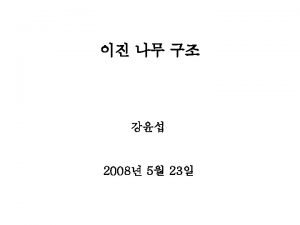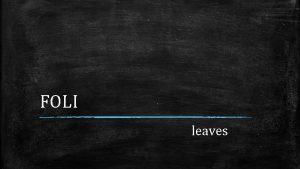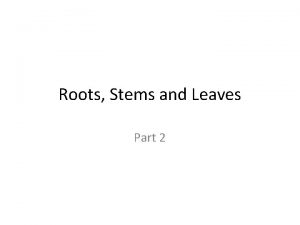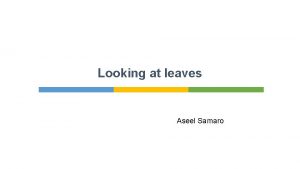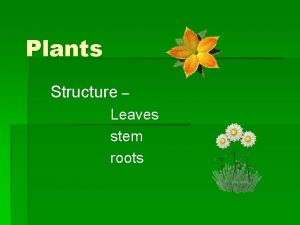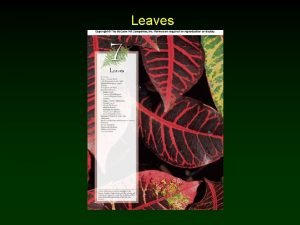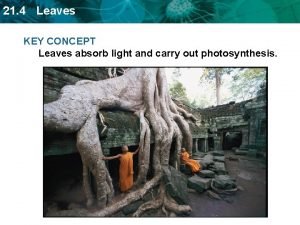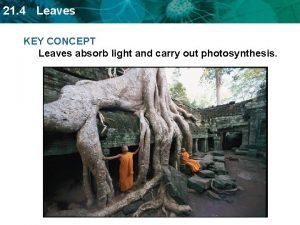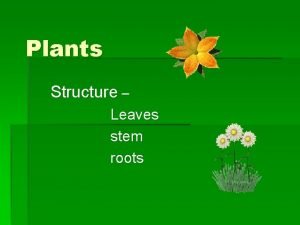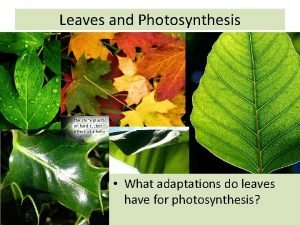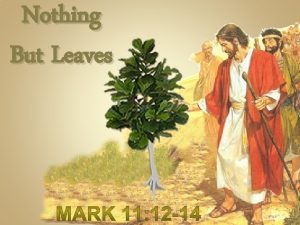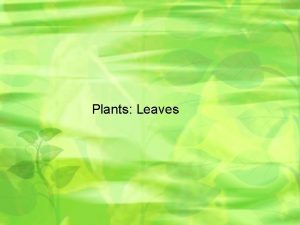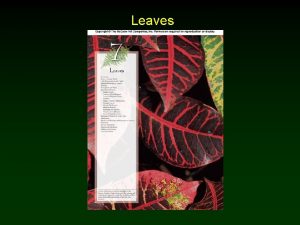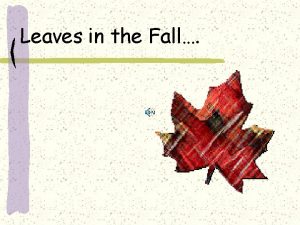Leaf anatomy Leaf anatomy Leaves start as outgrowths

































































- Slides: 65

Leaf anatomy

Leaf anatomy • Leaves start as outgrowths from apical meristem: leaf primordia.

Leaf anatomy • 3 primary meristems – protoderm: becomes _____ – procambium: becomes ______ – ground meristem: becomes ______.

• Epidermis: note cuticle, stomata • Veins with vascular tissues (_____ • _____) • Supply water & nutrients, remove sugars for transport elsewhere. Leaf anatomy

Leaf anatomy • Mesophyll – Parenchyma tissue layers (palisade and spongy: do ______.

Monocot vs dicot anatomy • Stem: Dicot with bundles _____. Pith and cortex present. • Monocot: scattered vascular bundles. No ________.

Monocot vs dicot anatomy • Root: Dicot, < 6 phloem patches, no pith

Monocot vs dicot anatomy • Root: Monocot, many _______, pith present

Monocot vs dicot summary • Note root system type: dicot often with single major root axis (taproot system), monocot lacking this (fibrous root system)

Plant Growth Phenomena • Hormones: molecules produced in small amounts that change _________ • Can inhibit or stimulate processes to occur • 5 major types: – auxins – cytokinins – gibberellins – ethylene – abscisic acid

Auxins • Promote stem elongation and growth • Example, ______. Bending of stem toward light

Auxins • Also involved in _______: suppression of lateral meristems by apical meristem

Auxins • Can stimulate production of _______ roots (roots produced on stem or leaf) • Useful in rooting cuttings (asexual plant reproduction)

Cytokinins • Stimulate cell division where auxin is also present • Acts as ______ hormone (keeps detached leaves green).

Gibberellins • Promote stem elongation • Mutant plants with low amounts are _____ (internode lengths short)

Ethylene • Promotes fruit ripening • Stimulates ______ (dropping) of leaves, flowers

Abscisic acid • Induces formation of winter buds (bud scales, dormant meristem) • Involved in opening and closing of _______ • Can cause seed dormancy

Other plant growth phenomena • Gravitropism: response of stem/root to gravity • Stems bend away from gravity (______ gravitropism) • Roots bend toward gravity (_____ gravitropism)

Other plant growth phenomena • Mechanism unclear. May involve ________ called statoliths (in root cap of root, in parenchyma cells of stem)

Other plant growth phenomena • Thigmotropism: response of plant to _____ • Examples: Many tendrils grow toward stimulus and wrap around object

Turgor movement • Not growth: involves loss of water pressure (turgor pressure) in some cells • Can be reversed • May involve rapid movement (electrical signal) • Ex, sensitive plant

Flowering • Some plants use daylength as flowering cue • Can measure length of night (photoperiod) by pigment called _______

• Long day plants: flower when night is ____ than some critical time • Short day plants: flower when night is _______ than some critical time • Day neutral plants: don’t use photoperiod as flowering cue Flowering

Flowering • Use: Can make some plants bloom when we want them • Ex, poinsettia. A short-day plant that growers make flower for Christmas holidays.

Plant transport • Phloem: sugars and water (often from leaf to root) • Xylem: water and minerals from root to shoot • Movement driven by _______: measure of tendency of water to move from one place to another

Plant transport • Water potential is affected by: – solutes (high solutes = ______ tendency to move) – pressure (high pressure = ______ tendency to move) – tension (pull: high tension = ______ tendency to move).

Water transport • Xylem: water and minerals from root to shoot • How much of water remains in plant? <____%!

Water transport • Transpiration: evaporation of water from leaves • Driven by _______ from leaves. Water under tension. Water potential high in soil and low in air.

Water transport • Driven by pull from leaves. Water under tension. Water potential high in soil and low in air.

Water transport • Transpiration greatly controlled by stomata • Stomata open in ____ but can close if plant lacks sufficient water. Stomata!

Sugar transport • Phloem: sugars and water • Flow from ______ to _____ • Pressure flow mechanism

Sugar transport • Source: lots of sugar dissolved in water. Generates pressure as water flows in to _______ sugar • Sink: little sugar dissolved in water. Low pressure as water flows out • Creates ______ gradient that moves fluid thru sieve tubes.

Sugar transport • Result: sugar flows to wherever demand is high

Secondary Growth

Secondary Growth • Two types of growth • Primary growth: up and down. Generated by apical meristems. Form _____ tissues • Secondary growth: growth in girth. Generated by lateral (secondary meristems). Form _____ tissues. • All plants do primary growth • Woody plants do _____ growth

Secondary Growth • Lateral meristems – 1) _______: makes new phloem and xylem – Called ____ phloem and xylem tissues (vs. primary phloem and xylem made directly from procambium) – Function: xylem takes water + minerals to leaves, phloem takes sugars to roots

Secondary Growth • Lateral meristems – 2) ______: makes new cell type, cork cell. Cork cells with primary wall impregnated with waxy material (_______). Dead at maturity. Forms waterproof layer on outside of body to replace epidermis. – _____: Tissue composed of cork cells and made by cork cambium. Also is a secondary tissue.

Secondary Growth • Stem cross section

Secondary Growth • Vascular bundles contain _________ • Located between primary xylem and phloem • Meristematic: can still do ________

Secondary Growth • Residual procambium cells start to divide • Produce new cells _______

Secondary Growth • Parenchyma cells between bundles also start to divide • Together form solid ring of cells, all dividing laterally • This is _________

Secondary Growth • Vascular cambium makes secondary xylem on _____, secondary phloem on _____ • Note how cambium moves outward over time

Secondary Growth • Note arrangement of primary phloem and secondary phloem, primary xylem and secondary xylem

Secondary Growth • Secondary xylem may contain: – – 1) Vessel elements 2) Tracheids 3) ______ 4) Fibers • Secondary phloem may contain: – – 1) Sieve tube elements 2) Companion cells 3) Parenchyma 4) ______

Secondary Growth • Two

Secondary Growth • Later secondary growth

Secondary Growth • First cork cambium: Forms under ______

Secondary Growth • Cork cambium: Makes files of cork cells to outside. Forms first _____. Epidermis cut off from rest of stem and dies.

Secondary Growth • Problem: cork cells are dead at maturity. Cork layer cannot _____ as vascular cambium continues to grow. • Solution: form new ______ in cortex under old one • After time, several _____ build up (yellow lines). Newest (inner) one cuts off water to layers beyond it and they _______.

Secondary Growth • Periderm replaces epidermis. How get _______ into stem?

Secondary Growth • Lenticels: Loosely packed _____. Allow oxygen to diffuse into stem to support living cells there.

Secondary Growth • Note ____ made by vascular cambium: Form ____ transport system (often parenchyma cells) • In phloem: phloem ray • In xylem: xylem ray (wood ray)

Secondary Growth • In temperate zone, cambium activity varies between _____ and ______ in growing season • Spring: big cells (_______ wood). • Summer: small cells (_______ wood). • Form growth ring (tree ring): one season’s growth • Ex, pine (mostly tracheids)

Secondary Growth • Ex, oak (note vessels, thick-walled _____)

Secondary Growth • Young tree section: Note rays here (phloem and xylem) • Also note growth rings: early and late wood • How old was this stem when cut?

Secondary Growth • In older tree: wood is secondary xylem • Heartwood: old non-functional xylem • ____: younger often functional xylem

Secondary Growth • Bark: From vascular cambium outward • ______: From current cork cambium outward (all is dead) • _____: From vascular cambium to current cork cambium. Contains functional secondary phloem

Secondary Growth • Removing inner bark is deadly: girdling tree often will kill it • Why? Roots ______ • Why? No ____ from leaves.

Secondary Growth • Flow chart, showing how primary and secondary tissues develop in stem

Secondary Growth • Note that roots of woody plants also do secondary growth • Vascular cambium forms from _____ • First cork cambium forms in _______.

Secondary Growth • So outer cortex and epidermis are sloughed off and lost

Uses of Growth Rings • 1) Fire frequency • Break in bark (_____) allows fire to burn through vascular cambium into wood • Leaves burned layer • If tree survives, can have record of fires in wood. Ponderosa pine, WY

Uses of Growth Rings • 1) Fire frequency • Helpful information when trying to determine “natural” frequency of fires for managing forests.

Uses of Growth Rings • 2) Climate patterns (__________) • Width of rings can indicate growth conditions for tree (rainfall, etc. ) • Can reconstruct climate information • Oldest reconstructions go back 8, 000 yr B. C.

Uses of Growth Rings • 2) Climate patterns • Oldest reconstructions from bristlecone pine wood go back as far as ____ yr B. C.
 Maple leaf and oak leaf homologous
Maple leaf and oak leaf homologous Leaf and non leaf procedure
Leaf and non leaf procedure Site:slidetodoc.com
Site:slidetodoc.com Triage protocol
Triage protocol Perfoliate leaf example
Perfoliate leaf example Leaf anatomy coloring key
Leaf anatomy coloring key Kranz leaf
Kranz leaf Leaf anatomy
Leaf anatomy Non symmetric projectile motion
Non symmetric projectile motion A small airplane leaves an airport on an overcast day
A small airplane leaves an airport on an overcast day Alternate opposite whorled leaves
Alternate opposite whorled leaves Morphology of flowering plants
Morphology of flowering plants Poison ivy leaves
Poison ivy leaves Ar leaves and passes
Ar leaves and passes Jaxon earned $39 raking leaves
Jaxon earned $39 raking leaves Photosynthesis is important to animals because flocabulary
Photosynthesis is important to animals because flocabulary Parts of leaves and its function
Parts of leaves and its function Standard error in biology
Standard error in biology Label the parts of leaf
Label the parts of leaf June 2016 grade boundaries
June 2016 grade boundaries Vlado taneski
Vlado taneski 3 parts of the cell theory
3 parts of the cell theory Alternate opposite whorled leaves
Alternate opposite whorled leaves Perfect tense leave
Perfect tense leave Eats shoots and leaves joke
Eats shoots and leaves joke Giraffes like acacia leaves and hay
Giraffes like acacia leaves and hay Matt monro autumn leaves
Matt monro autumn leaves What is the acceleration of free fall
What is the acceleration of free fall John leaves school to go home
John leaves school to go home Makoi phyllotaxy
Makoi phyllotaxy Alliteration for forest
Alliteration for forest Objectives in making salad
Objectives in making salad To a daughter leaving home and poem for my sister
To a daughter leaving home and poem for my sister Buildungsroman
Buildungsroman Approved leaves
Approved leaves Leaf structure cube
Leaf structure cube Inang bayan poem
Inang bayan poem Leaves and passes
Leaves and passes What is leaf morphology
What is leaf morphology Dichotomous key to the conifers
Dichotomous key to the conifers The leaves are little yellow fish swimming in the river
The leaves are little yellow fish swimming in the river What is king creon’s reaction to teiresias’ message?
What is king creon’s reaction to teiresias’ message? What does jocasta say she did with her baby
What does jocasta say she did with her baby Mayo 25 1888 el filibusterismo
Mayo 25 1888 el filibusterismo Parts of the plants and their functions
Parts of the plants and their functions Stem which we can eat
Stem which we can eat Sum of forces equation
Sum of forces equation Tap root and fibrous root
Tap root and fibrous root Bagu leaves
Bagu leaves Cuticle leaves
Cuticle leaves Function of shoot system
Function of shoot system Animal ear like leaves
Animal ear like leaves Paraphrase any trip to italy
Paraphrase any trip to italy Leaves structure
Leaves structure What is the reason for the windmill’s initial collapse?
What is the reason for the windmill’s initial collapse? Read the tea leaves idiom
Read the tea leaves idiom Evs ppt for class 4
Evs ppt for class 4 Leaves branches trunk and roots song
Leaves branches trunk and roots song What part of the plant carries and protects the seed
What part of the plant carries and protects the seed Branch of biology that groups and names organisms
Branch of biology that groups and names organisms Blood on the leaves key
Blood on the leaves key Structure of stomata
Structure of stomata Words are like leaves and where they most abound
Words are like leaves and where they most abound Alternate vs opposite leaves
Alternate vs opposite leaves The leaves of utricularia plant are modified into
The leaves of utricularia plant are modified into Leaf margin
Leaf margin
